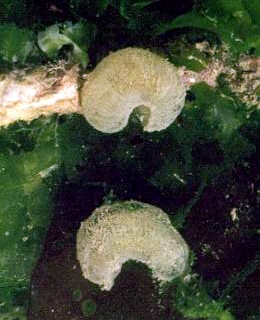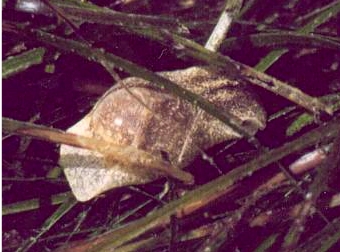Haminoea zelandiae from Tauranga, New Zealand
June 6, 2003
From: Paul Furneaux

Hi Bill,
Thanks for your comments, the Philinopsis pix look great. I am including some Haminoea zelandiae photos with this message. They are extremely numerous where I have been working [Tauranga Harbour, east coast, Nth Island, New Zealand]. I have not done any counts of them but they would be from 10 to 30 per square metre in some situations, particularly in some patches of dense Zostera cover, and also in some areas of Ulva.
Both of these plants have been cause for concern in for quite different reasons, Zostera, because very large areas of it have disappeared over the past 40 - 50 years and thus a great deal of good habitat has been lost, and Ulva, because periodically it grows so extensively that it accumulates in quite thick layers or piles and becomes a problem in some localities. However both plants seem to be important to Haminoea zelandiae. I have one photo of an individual that is feeding on Ulva, " holding" it edge on, and they also appear to graze the algae that grow on the surface of the Zostera leaves. Their egg masses are also extremely common.
I have not yet found a live example of Bulla but their empty shells are reasonably common so perhaps a nocturnal excursion is called for.
Regards,
Paul Furneaux.
P.Furneaux@xtra.co.nz


Thanks Paul,
Photos of H. zelandiae certainly bring back memories. It is certainly one of the commonest sea slugs in New Zealand. It feeds on both the microalgal film growing on the leaves of Zostera and also on similar films or layers on soft sediments and hard surfaces. It also eats Ulva and 'filamentous' algae such as Enteromorpha. Actually it completely lacks self control when feeding and certainly in aquarium conditions it would eat Enteromorpha non-stop until it reached the stage where it would be defecating green pellets of undigested algae at one end while continuing to stuff in more food at the other end.
Your photos show the range in colour of this species from almost pure black to a light mottled brownish colour. The upper right photo of an animal ploughing through the sand, catching the fine sediment in the mucus sheet which covers its headshield, is a good example of how the headshield and its anterior mucus glands work together to allow the animal to live in these silty environments without clogging up the organs of the mantle cavity.
Best wishes,
Bill Rudman.
Related messages
-
Egg mass of Haminoea zelandiae
From: Bill Rudman, October 27, 2006 -
Colour variability in Haminoea zelandiae
From: Bill Rudman, October 27, 2006 -
Haminoea zelandiae egg masses
From: Paul Furneaux, December 8, 2003 -
Shells of Haminoea zelandiae
From: Bill Rudman, June 6, 2003 -
Gizzard plates of Haminoea zelandiae
From: Bill Rudman, December 23, 1999
